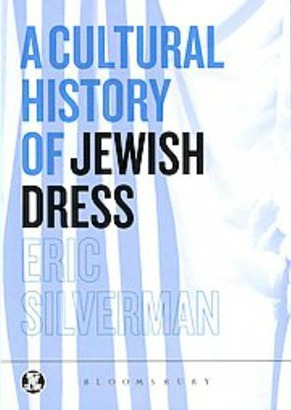Why do Jews wear yarmulkes? Why do Hassidic men wear black? Wheelock College professor and cultural anthropologist Eric Silverman has just written “A Cultural History of Jewish Dress,” the first comprehensive account of how Jews dress and why, from ancient Israel to today. I chatted with him about his fascinating new book and asked him to explain some of our most unusual fashion customs.
What got you interested in the history of Jewish dress?

How ironic, I thought! Here we have this quintessential Jewish item of dress—something everybody, or at least everybody in the West, would recognize as a sign of Jewish identity—adorned with global pop-culture figures, designs from a country that lacks Jews (Japan), and even a popular Latina girl on television and her non-kosher pet, a monkey. What does all of this say about Jewish identity?
To me, it says quite a lot; namely, that many Jews today are as thoroughly American as they are Jewish, and that they wish to display both identities simultaneously, wishing neither to hide one or the other, seeing both as equal and valid. It also says that many Jews now feel comfortable with their Jewishness such that they are willing to “play” with this identity, to have fun with it. And I was also struck by the idea that while the yarmulke signals one’s “tribal” affiliation, it also allows one to express individualism, tastes, preferences, affiliations, hobbies and so forth. Here, the yarmulke fused classic American consumerism with a sense that the Jewish tradition—a communal tradition—sets us apart from generic American identity. From these yarmulkes I then began to think more broadly about how clothing represents Jewish identity through history—the tensions, paradoxes, conversations and debates—and I was off and running with the research for the book.
At what point did Jewish men start covering their heads?
It seems clear from historical records that Jewish men were covering their heads to signal their Jewishness in the medieval era—but not as an absolute obligation. There is no evidence that head coverings were seen in the biblical era as obligatory or even optional. Part of the adoption of this religious custom arose in response to the fact that the Catholic Church and various European authorities began to require Jews, at least in principal, to dress in distinctive attire—to mark Jews as “otherly,” degraded and marginal. Often these edicts mandated certain distinctive headgear. When rabbis began to legislate that Jewish men wear hats, it was partly a way, I propose, to “seize” an outsider’s degrading edict and make it “our own,” to take control of the symbols of oppression and turn them into something affirming and positive for Jewish identity.
It is also important to note that Europeans throughout history, up until the early 20th century, wore hats. Hats were a type of identification card that signaled one’s role in society. So everybody wore hats; not just Jews. It was only when non-Jews finally stopped wearing hats as a matter of everyday etiquette that Jews began to look distinctive on account of their hats. The presence of a head covering was not really seen as uniquely Jewish—by Jews or non-Jews—until everybody else took off their hats. And at that moment, which begins in the late 19th century, traditional Jews began to see their hats as a sign of Jewishness and resisting calls for assimilation.
I trace the idea that it is important for Jewish men to cover their heads as a matter of religious identity that sets us apart from others to the early 20th century. It is, in this respect, what social scientists call an “invented tradition.”
I didn’t realize Nazis making Jews wear yellow triangles wasn’t a new policy, but a policy that has existed for thousands of years in one form or another. What are other ways that Jewish dress has marked Jews as different from others?

In many instances, these legal edicts did not merely specify what Jews should wear, but they also specified what Jews could not wear. Jews in different places and times could not wear certain buttons, furs, fabrics, colors, styles, patterns and so forth. It is only in the modern era that any person can dress as he or she pleases as a matter of personal preference. For most of human history, people were required by law or convention to announce visually their status and identity.
For Jews, however, the key issue for me is that there were two forces behind these rules: On the one hand, non-Jewish authorities wanted Jews to appear different since Jews, in their view, were not equal to Christians and Muslims; they were less than fully legitimate humans. On the other hand, Jewish authorities also wanted Jews to dress distinctively to preserve the religion as unique and privileged.
No one is going to believe me about this one, but could you please explain why I might one day have to spit in the shoe of one of my husband’s three brothers? (God forbid, of course.)
In ancient Israel, as throughout the ancient Middle East and some places even today, societies practice a marriage pattern that anthropologists call the “levirate”: If a husband dies, his wife is supposed to marry one of his brothers. This is largely a way to make certain that his property remains within the lineage or kin-group. In those days, a man could wed multiple wives.
At any rate, sometimes the brother would refuse. In this instance, there needed to be some sort of public ritual that would “release” the widower from her obligation to marry a surviving brother. This ritual, in the Torah, specifies what to us seems like a bizarre gesture: the widower pulled a shoe from her brother-in-law’s foot and spat in his face. She also publically said something akin to, “This is what happens to a man who does not want to continue to build his deceased brother’s house.” To us, this gesture is disgusting. But spitting is not seen this way everywhere. Indeed, in Greece and parts of the Mediterranean today, spitting on someone is a way of averting the evil eye.
Rabbis incorporated this gesture into rabbinic culture, and since the rite was in the Torah, they could not simply get rid of it. Eventually they stopped spitting in the man’s face and did so only on the floor. But among the Orthodox, such rituals remain binding, and they have, as I discuss in the book, special shoes for the ceremony, otherwise a widower is never able to remarry. I might also add that as a cultural anthropologist who also studies a community in Papua New Guinea, this rite does not strike me as weird or odd. Every religion and culture has ceremonies that strike others as strange or inexplicable. Jews are no different. But each ritual gesture, however bizarre to outsiders, makes sense or seems “normal” in its proper setting.
Now, the question is: What is the symbolism of this shoe ceremony? And to answer this question, I draw on a bit of Freudian analysis, which has considerable cross-cultural support. And lest I give away my analysis, I will simply say, think Cinderella, only in reverse!

This post has been contributed by a third party. The opinions, facts and any media content are presented solely by the author, and JewishBoston assumes no responsibility for them. Want to add your voice to the conversation? Publish your own post here. MORE


